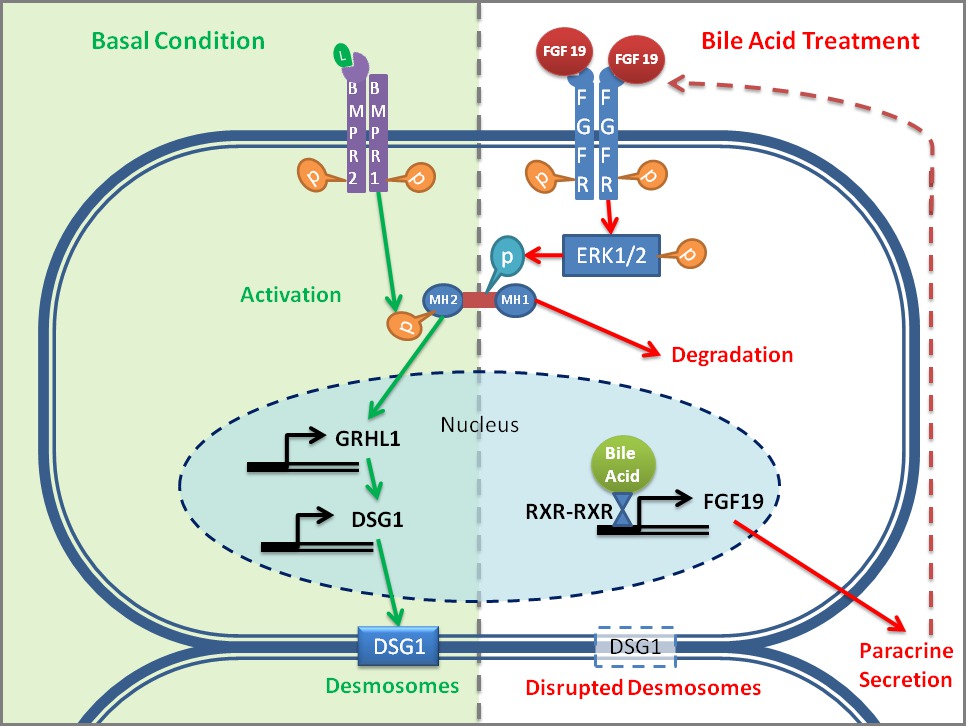
|
 |
Back to 2017 Posters
UNCONJUGATED BILE ACID REDUCES DESMOSOMAL GENE EXPRESSION IN ESOPHAGEAL CELLS BY INHIBITING BMP SIGNALING THROUGH NUCLEAR RECEPTOR MEDIATED FGF-19 TRANSCRIPTION
Sayak Ghatak*4, Amy LaLonde3, Tanya Malhotra5, Liana Toia1, Derick Peterson3, Tony E. Godfrey2, Joseph Wizorek4, Christian Peyre4, Carolyn Jones4, Eileen Redmond4, Jeffrey Peters6
1Pediatrics, University of Rochester Medical Center, Rochester, NY; 2Surgery, Boston University, Boston, MA; 3Biostatistics, University of Rochester, Rochester, NY; 4Surgery, University of Rochester Medical Center, Rochester, NY; 5Physics, University of Rochester, Rochester, NY; 6University Hospitals , Cleveland, OH
Objectives: Barrett’s Esophagus (BE) is a precancerous lesion in which the normal squamous epithelium of the esophagus undergoes columnar metaplasia and the esophageal epithelium loses the expression of genes involved in squamous differentiation as it progresses to BE due to long-term exposure to reflux. Bile acid, both conjugated and unconjugated, at an acidic pH forms the chief component of reflux. Bile acid can affect cellular processes acting as signaling molecules. The aim of our study was to determine whether conjugated or unconjugated bile acid is responsible for down-regulation of squamous differentiation in primary esophageal cells, and to identify the intracellular signaling pathways involved in the process.
Method: h-TERT-transformed primary esophageal squamous cells (EPC1) in transwell culture were treated with cocktails of unconjugated and conjugated bile acid at pHs 5 and 7.4, in 10 minute pulses three times a day for 6 days. Cells were pre-treated with or without Bone Morphogenetic Protein (BMP) ligands. Epithelial barrier function was assessed by measuring transepithelial electrical resistance daily. Gene expression was assessed using real-time quantitative PCR and western blots. BMP activation was assessed by detecting phospho-SMAD using western blot. Statistical significance was calculated using Bonferroni-adjusted α=0.05 level.
Results: Unconjugated bile acid at pH5 reduced epithelial barrier function concomitant with inhibition of genes (GRHL1, IVL, DSG1, K10) involved in squamous differentiation in EPC1 cells in transwell culture, whereas conjugated bile acids did not have any significant effect. These results suggest an intracellular signaling mechanism of action of bile acid, as opposed to a detergent action, to reduce squamous differentiation in primary esophageal cells. This was confirmed by strong FGF19 induction by unconjugated bile acid at pH5. Bile acid at pH5 also reduced phospho-SMAD levels in EPC1 cells. Pre-stimulation of cells with BMP ligands partially abrogated bile acid mediated reduction of expression of genes involved in squamous differentiation.
Conclusion: Under basal conditions in stratified epithelial cells, BMP signaling drives the expression of genes involved in squamous differentiation (GRHL1, DSG1). Approximately 50% of the unconjugated fraction of the bile acid cocktail at pH5 accesses intracellular compartment by simple diffusion. Once inside the cell, bile acid by binding nuclear receptor complexes transcribes down-stream targets like FGF19, which is known to inhibit BMP signaling acting through ERK1/2 mediated R-SMADs degradation, thus reducing squamous differentiation. Ligand mediated BMP stimulation partially abrogates the inhibitory effects of unconjugated bile acid, possibly by allosteric phosphorylation of R-SMADs.
Squamous differentiation associated genes with their functional relevance.
| Gene Name | Gene Symbol | Functional Relevance | | Grainyhead like-1 | GRHL1 | Squamous specific transcription factor | | Desmoglein-1 | DSG1 | Desmosomal protein, epithelial barrier formation | | Involucrin | IVL | Structural protein found in differentiated stratified squamous epithelium | | Keratin 10 | K10 | Cytoskeletal protein, epithelial barrier formation | | Fibroblast growth factor 19 | FGF19 | Transcriptional target of bile acid nuclear receptor complexes |
 Figure: Bile acid reduces squamous differentiation by inhibiting BMP signaling- a hypothetical mechanism of action.Important Note: Figure: Bile acid reduces squamous differentiation by inhibiting BMP signaling- a hypothetical mechanism of action.Important Note: The BMP inhibition and unconjugated bile acid data for this abstract was presented respectively at Digestive Disease Week 2013 (SSAT Mo1836) and Digestive Disease Week 2014 (SSAT 520), and features in the doctoral thesis of Dr. Sayak Ghatak, Biology, University of Rochester (URL: http://hdl.handle.net/1802/28858). Ligand mediated BMP stimulation data is hitherto unpublished. None of the data presented here has been published in any peer-reviewed journal article.
Back to 2017 Posters
|


